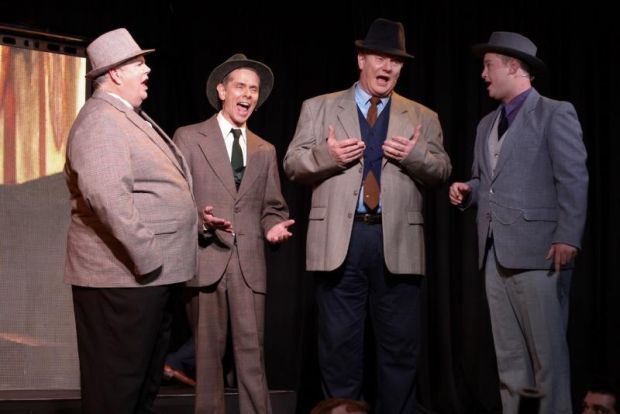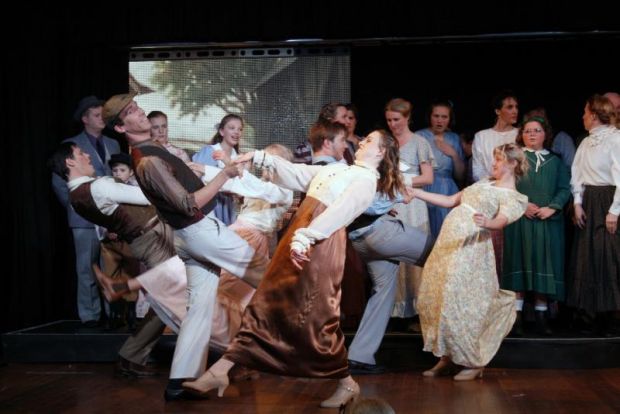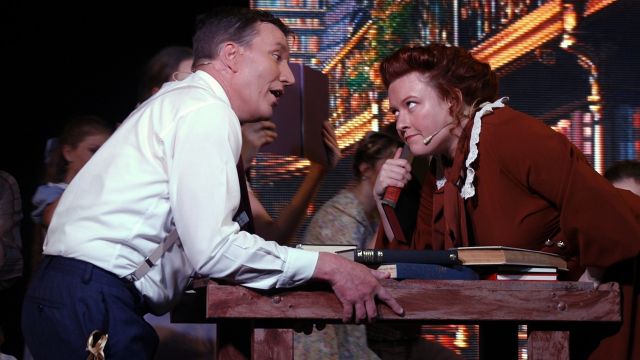The Music Man
In writing one of those ‘perfect’ musicals from Broadway’s Golden Age, composer / lyricist Meredith Willson drew his inspiration for The Music Man from his own musical career, including his time in the 1920s as a member of ‘The March King’ John Philip Soussa’s band - not one of those 76 trombonists, though, but a flute and piccolo virtuoso. The Music Man’s long path to Broadway and winning the Tony Award for Best Musical, beating out West Side Story, took eight years, numerous re-writes and saw about as many songs as actually reached the stage consigned to the ‘trunk’.

Rich in humanity as well as great tunes, it's a show that works in both intimate low budget community productions like this one at NUCMS, and bigger, flashier incarnations.
Wisely, director Mel Hogan has chosen sparse settings and props on the small Normanhurst stage. LED screens suggest the settings – even split locations when required. That design choice facilitates scene changes, creates space for a large cast, and allows choreographer Chris Bamford to create lively dance numbers which never feel crowded (aided by his adept rotation of the performers).
 Salesman Harold Hill dupes the folks of River City Iowa with the promise of boys’ band; he sells them instruments, uniforms and tuition books, undertaking to teach the children to play. The scam? He knows nothing about music. Hill has conned town after town, disappearing as soon as he’s collected the cash. The charismatic shyster is a musical theatre marathon role, and John Hogan impresses – we really like his Harold Hill, despite knowing he’s a crook. Hogan nails the songs – the patter of ‘Ya Got Trouble’, the playful banter of ‘Marion The Librarian’, and the bravura of ’76 Trombones’, contrast with a brief late show romantic reveal.
Salesman Harold Hill dupes the folks of River City Iowa with the promise of boys’ band; he sells them instruments, uniforms and tuition books, undertaking to teach the children to play. The scam? He knows nothing about music. Hill has conned town after town, disappearing as soon as he’s collected the cash. The charismatic shyster is a musical theatre marathon role, and John Hogan impresses – we really like his Harold Hill, despite knowing he’s a crook. Hogan nails the songs – the patter of ‘Ya Got Trouble’, the playful banter of ‘Marion The Librarian’, and the bravura of ’76 Trombones’, contrast with a brief late show romantic reveal.
Librarian and piano teacher Marian isn’t seduced by Hill’s charm, nor convinced by his phony credentials, but Sarah Cherlin’s lovely soprano renditions of ‘Goodnight My Someone’, ‘My White Knight’, ‘Will I Ever Tell You’, and finally ‘Till There Was You’ beautifully capture the emotional subtext beneath the credible no-nonsense exterior she creates.
The juxtaposition of the same tune for Marian’s wistful, waltz time ‘Goodnight My Someone’, and Harold’s rousing march ‘76 Trombones’ which follows it early in the show, then their late show blending as love emerges, a subliminal element in Willson’s song-writing always delights me.
Each of three cast groupings almost steal the show: the opening clutch of travelling salesmen rattling along in a train carriage, a barbershop quartet where animosity morphs into friendship through harmonies, and the roving group of town gossips. All worked delightfully. The tightly choreographed train scene was detailed, highly rhythmic and spot on, the musical camaraderie of the quartet charming, and the ladies’ stereotyped gossip and ‘Grecian Urn’ scene were great fun.

As Hill’s former accomplice Marcellus, Tim Martin is engaging and exuberant. Jenny Farrell is warm, wise and knowing as Marian’s mother Mrs Paroo. Shane Andrews is a suitably pompous Mayor Shinn, paired well with Jess Ferraro’s domineering turn as his wife Eulalie.
Marc Calwell’s Charlie Cowell lands both the determination and sleaziness of the anvil salesman determined to un-mask Hill. Mirrie Van Dijk as the Mayor’s mildly rebellious daughter Zaneeta, and Darren George as her bad boy beau Tommy work well together.
In the younger roles, Savannah Hogan (Amaryllis) and Georgia Hogan (Gracie) give bright, lively performances, while Oscar Ryan is appropriately withdrawn and sombre as Winthrop.

Being family-based, family-friendly church related company, and welcoming all comers, with no chorus auditions, there is a quite a range of stagecraft ranging from experienced to novice.
I’m reminded that as a teenager I was welcomed into a community theatre ensemble despite my two left feet, for which I am eternally grateful.
While some performers, not unlike a younger version of myself, are still to find their finish and finesse, the abundance of joy on stage is a hallmark of this production. The involvement of multiple family generations is another key element, threaded as they are through the cast, orchestra, crew, production team and front of house of NUCMS.
Although some of less experienced members of the company may still be ‘finding their feet’ on stage, the involvement of one of our best community theatre choreographers in Chris Bamford shows that NUCMS clearly has an eye to developing their members’ talents.

Along with the opening train scene, which I’ve already mentioned, much of the choreography in The Music Man is more staged movement than dance, with lots of delightful moments. As I also mentioned earlier, Chris rotates the cast so effectively that the action always feels lively and fluid, while he’s keenly aware of every individual’s abilities. Happily, the company also get to really cut loose in lively routines including the storytelling of the library scene, and the high-spirited ‘dance craze’ number ‘Shipoopi’, the show’s most full-on, vibrant dance-for-dance-sake’s number.
Musical Director Rich Ferraro has drawn generally excellent work from both cast and orchestra, while the sound by Cameron Mitchell is very well balanced.
I’ll stop there, as the NUCMS village includes so many members integral to the show in technical, costuming, construction, crewing and other diverse capacities.

I thoroughly enjoyed my special matinee afternoon with this community theatre family.
Harold Hill leads into ’76 Trombones’ with an early (probably Fictional) recollection of band music. I’m reminded, if you’ll indulge me for a moment, of my own boys’ band experiences (I’m guessing that The Music Man resonates with memories childhood music lessons for many of you). I delight in the thought that the show’s creator Meredith Willson began his illustrious musical journey playing Bass Drum with Salvation Army, the same delicate instrument which teenage me banged out the beat on in parades with the Burwood Police Citizens Boys’ Club band.
Neil Litchfield
Subscribe to our E-Newsletter, buy our latest print edition or find a Performing Arts book at Book Nook.

